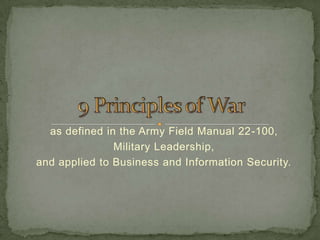
9 Principles Of War
- 1. as defined in the Army Field Manual 22-100, Military Leadership, and applied to Business and Information Security. 9 Principles of War
- 2. Principle #1 Objective Direct every operation towards a clearly defined, decisive, and attainable objective.
- 3. Principle #2 Offensive Seize, retain, and exploit the initiative.
- 4. Principle #3 Economy of force Allocate minimum essential combat power to secondary efforts.
- 5. Principle#4 MASS Concentrate combat power at the decisive place and time.
- 6. Principle #5 Surprise Strike the enemy at a time, at a place, or in a manner for which he is unprepared.
- 7. Principle #6 Maneuver Place the enemy in a position of disadvantage through the flexible application of combat power.
- 8. Principle #7 Unity of command For every objective, ensure unity of effort under one responsible commander.
- 9. Principle #8 Security Never permit the enemy to acquire an unexpected advantage.
- 10. Principle #9 Simplicity Prepare clear, uncomplicated plans and concise orders to ensure thorough understanding.
- 11. “War is the continuation of policy (politics) by other means.” “If you entrench yourself behind strong fortifications, you compel the enemy to seek a solution elsewhere.” “Never forget that no military leader has ever become great without audacity. If the leader is filled with high ambition and if he pursues his aims with audacity and strength of will, he will reach them in spite of all obstacles.” - Karl von Clausewitz
Hinweis der Redaktion
- Business and Information Security fields are undoubtedly, WAR. Dominating a market or protecting information resources is not done easily. You need a system to determine the unique strengths of your employees and to address their personal growth. This insight will let you match ability with action. Engaging your workforce and help them achieve personal success will transform your company into a highly profitable and aligned organization.Carl Von Clausewitz was a military philosopher during the time of Napoleon. His most famous contribution is the book, On War, which outlines nine principles of war that are still used in officer training schools for many armies including the United States and Canada.The 9 principles of war provide general guidance for conducting war and military operations at the strategic, tactical, and operational levels.These 9 principles are the enduring bedrock of Army doctrine, and can easily be incorporated into many aspects of business and security.
- Choose an objective and stick with it.Objectives must be clearly defined.Actions must contribute to the goals of the higher headquarters.Objectives drive all activities.Real leadership begins at the beginning. To engage your employees, you must communicate precisely what the objectives are. This is a war that cannot be won alone.
- Seize the Initiative. The time to strike is when the opportunity presents itself.This is the essence of successful operations and key to achieving decisive results.This dictates the nature, scope, and tempo of operations and is essential to maintain the freedom of action necessary for success and to react to rapidly changing situations.Once you have determined your objectives and clearly communicated them to your employees, you will have a team that is ready to seize the opportunities that arise in your market.
- Focus on the key objective before working toward secondary objectives.Allocate limited forces wisely.Accept only prudent risk in selected areas to achieve superiority — overwhelming effects — in the decisive operation.Exercise discriminating employment and distribution of forces.Identify your priorities and establish the details of your objectives. Minimum essential “resources” means the focus of time and money must be on the primary objectives without neglecting the small details and lower priorities.
- Mass the effects of combat power to overwhelm enemies. “Get there first with the most”.Mass resources in time and space to achieve both destructive and constructive results.Overwhelm the entire enemy defensive system before he can react effectively.Attack a combination of elements critical to the enemy force to shatter its coherence: Leadership Information Firepower Maneuverability ProtectionDetermine the most efficient use of your employees. This is where personal growth comes into play. To know precisely who to assign to what, you need a system to determine the unique strengths and goals of your employees. Determine your innovators, brainstormers, organizers, communicators - find the employees with the strengths to match each objective.
- Attack when the enemy least expects it.Provides a temporary combat multiplier.It is necessary that the enemy become aware too late to react effectively.Innovate. This cannot be properly done if you do not know the unique strengths of your key talent. With the alignment of strength to action, you can maximize the hidden opportunities that arise in your field.
- Always move towards more advantageous positions.Concentrate and disperse resources to place and keep the enemy at a disadvantage.Includes the dynamic, flexible application of leadership, firepower, information, and protection.Place your adversaries or competitors in a position of disadvantage through a flexible application of resources. With the right person in the right place, the company will be able to maximize each and every opportunity. Take the time to communicate objectives and to discover the strengths and goals of your employees. By doing this, you will have shown them that you believe in them, and they will be engaged when and where you need them to be.
- A single commander directs and coordinates the actions of all forces toward a common objective.Unifies action towards common goals and a single objective.For every challenge and objective, ensure synergy among all leadership members. In essence, this means two things: You now know exactly who should be in a position of leadership for each objective.You communicate your collective goals consistently throughout the company. In one word, alignment. By engaging your employees through invested and unified leadership, you can align employees with the objectives and goals of the company.